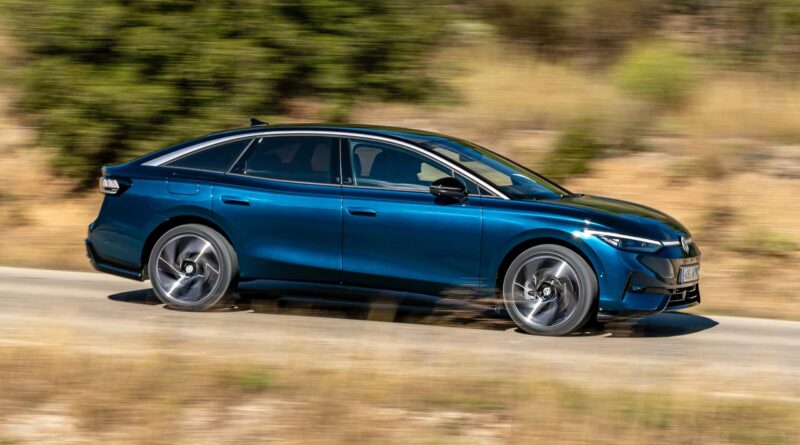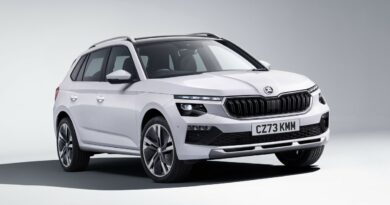2025 Volkswagen ID.7 First Drive: The Stealth Premium EV Sedan Choice
Nestled into the cockpit of the Volkswagen ID.7, the German brand’s new flagship electric offering, it didn’t take long for me to realize the vehicle brings a new level of premium to the “people’s car.”
The mid-sized sedan offers the best of both worlds: a near-silent, comfortable cabin for leisurely cruising and the benefit of instant torque, power, and the efficiency that comes with electric powertrains. It also sports Volkswagen’s improved Dynamic Chassis Control, and the system works exceptionally; more on that later.
I had the opportunity to spend a few hours driving an ID.7 in Southern France last week and I walked away genuinely impressed with Volkswagen’s new top-of-the-line electric sedan. But is this four-door good enough to cut it in a world owned by SUVs?
Exterior Design
Call it “modern elegance” meets “aerodynamic efficiency.” The ID.7’s sleek lines and refined contours present a contemporary aesthetic that embraces the typical simplicity of the Volkswagen brand while emitting a sense of sophistication. The design language isn’t far off the ID.4 crossover in countless ways, but as smaller cars and sedans often do, this one just wears it better.
The sedan’s distinctive front-end design is characterized by bold yet understated sleek LED headlights and a narrow LED strip for daytime running lights. The turn signals are integrated into the top of the housing and there are also side air curtains in front of the wheel housings to reduce drag.
The aerodynamic elements incorporated into the exterior, evident in its streamlined silhouette and sculpted body, are aimed at optimizing efficiency without compromising the vehicle’s visual appeal. It works, as the designers were able to achieve an impressively low coefficient of drag of .23.
Around back, the ID.7 sports a distinctive horizontal LED strip, that stretches into the wraparound LED taillights. Both the rear bumper and the lower diffuser are accented with high-gloss black paint.
Like its smaller ID.4 sibling, the ID.7 does not have a front storage compartment, or frunk as it’s often called. That’s unfortunate because EV buyers often look for that additional storage space. Luckily, the ID.7 does have lots of storage room behind the rear seats, and the absence of the frunk will be less noticeable.
Interior
The ID.7’s cabin was designed from scratch with a focus on spaciousness, comfort, and advanced technology. High-quality materials and a thoughtfully laid-out interior contribute to an inviting and luxurious atmosphere. Thanks to its 117-inch wheelbase, which is five inches longer than that of the Arteon, the ID.7 offers extremely generous space for both the front and rear passengers.
The minimalistic design of the dashboard is dominated by the all-new 15-inch horizontally oriented center touchscreen. It’s the largest touchscreen offered on any Volkswagen vehicle and is the same size as that on the Tesla Model 3 and Model Y. There’s a small driver’s display and a standard head-up display that adds augmented reality with interactive navigational directions, which I found to be very clear, even during the daylight hours.
I know seating comfort is subjective, but the ID.7’s cloth seats hit the spot for me. They are extremely comfortable and supportive in all the right places, and that’s before you use the standard seat heating, ventilation, or massaging features. The front seats offer over 40 inches of headroom and that, combined with the panoramic glass roof, makes the interior feel even larger than it is.
Speaking of the roof, the optional glass roof is electrochromic and uses a layer of a polymer-dispersed liquid crystal that allows the glass to instantly switch from transparent to opaque at your command.
The front seat massaging system has eleven different types of massage, and each allows you to select the intensity and duration of your pampering. I’ve had a few lower back surgeries stemming from an auto accident in 2012, and the lower lumbar massage setting felt heavenly.
I typically don’t use massaging seats in cars because I can’t get them to massage the right spot, but the level of customization in the ID.7’s standard seat massage system is very impressive, and I was able to get it customized perfectly.
Infotainment and Driver Assistance
Volkswagen’s current MEB-based EVs are generally very good vehicles, but so far they do have one major flaw: software. Volkswagen knows that, and in 2022 the company fired the Volkswagen Group’s Chairman, Herbert Diess, over the lingering software problems (among other things.)
However, with the ID.7, Volkswagen is taking a huge step forward to correct the problem with its software 4.0.
Version 4.0 is a vast improvement over the brand’s current software, and I spent a lot of time exploring whether I could overload the system by switching screens rapidly and scrolling through the options as fast as I could. Thankfully, the system was up for the challenge, and was able to keep up with my rapid-fire commands.
Wireless Apple carplay and Android Auto are standard. The layout of the tiles is simple and easy to navigate with the options listed across the top left side of the bright, crisp, 15-inch touchscreen. Along the bottom of the screen, you’ll find climate control options and below those, just off the edge of the touchscreen, there’s capacitive climate control settings which are now backlit.
That’s an improvement that was inspired by complaints that ID.4 owners had because the capacitive controls on that vehicle aren’t backlit, causing owners to have difficulty adjusting the settings in the dark.
Volkswagen’s Travel Assist advanced driver’s assist system (ADAS) is standard and includes a host of safety features including adaptive cruise control, cross-traffic alert, lane keep assist, and automatic lane changing. However, I struggled to get the lane-changing system to work properly as did other journalists that I spoke with at the drive event.
Volkswagen’s new APP 550 electric motor is more powerful and more efficient than its predecessor
Powerful Enough
I had the opportunity to drive the rear-wheel drive ID.7 which employs Volkswagen’s new APP 550 motor. The new powerplant provides 281 horsepower and 402 lb-ft of torque, which can propel the 4,788-pound sedan from zero to 60 mph in 6.5 seconds with an electronically limited top speed of 111.8 mph. While that may not be fast enough for the dragstrip, the ID.7 is more than powerful enough for just about any owner’s needs. The dual-motor all-wheel-drive version is expected to deliver 551 hp, which should cut the zero to 60 mph time down to about five seconds.
Smash the accelerator and you’ll find that instant torque of the electric motor pushing you back into the driver’s seat. It’s not quite as neck-snapping as we’ve experienced in some other high-powered electric vehicles, but there’s more than enough there to quickly accelerate past another vehicle when necessary, even at highway speeds.
The new APP 550 permanent magnet synchronous motor has more power and increased efficiency partially due to a rotor with strong permanent magnets that offer a high thermal load capacity, a new stator with thicker copper windings, a water heat sink for the outside of the stator, and a new, combined oil and water cooling system for higher thermal stability. The result is a motor that produces more power and does so using less energy, allowing the ID.7 with the same 77 kWh battery pack to go farther on a single charge than the smaller, lighter ID.4 can.
Gallery: 2024 Volkswagen ID.7 First Drive Review
Charging The ID.7
The ID.7 employs the same 11 kW onboard charger used in the ID.4 for AC charging. When coupled with a 48-amp charging source, the ID.7 with the 77 kWh (usable capacity) battery will recharge from a completely flat battery to 100% charged in about eight hours. ID.7s with the larger, 86 kWh battery will take an additional 45 minutes to an hour.
However, it’s an extremely rare occasion when an owner needs to charge from 0 to 100% because, with daily home charging, you only need to replenish what you used that day.
With a 48-amp home charger, you should replenish about 40 miles of driving range for every hour you charge. Therefore, if you were to drive 60 miles one day and plug the ID.7 in at night, it would be fully recharged in about 1.5 hours.
As for DC fast charging, the charging speed will depend on which battery you have. The 77 kWh battery can accept a peak charging rate of 175 kW, while the larger 86 kWh pack will charge at speeds up to 200 kW. Volkswagen quotes 10% to 80% charging times of 29 minutes for the 77 kWh models and only 25 minutes for ID.7 equipped with the larger battery since it can charge at higher speeds.
Volkswagen is one of the last remaining EV manufacturers that haven’t already announced a transition to Tesla’s North American Charging Standard (NACS) connector, but at this point, that feels like only a matter of time. The ID.7 will launch in mid-2024 with the J1772 connector for AC charging and use the CCS1 connector for DC fast charging. My guess is by 2025 they will begin installing NACS charging ports on the company’s EVs, just as the rest of the industry will.
Volkswagen ID.7 charge port
I was able to stop at a DC fast charger along the pre-planned drive route and charge my 77 kWh ID.7 from 44% to 82% in 20 minutes, which appears to be in line with Volkswagen’s estimates, considering I plugged in at a high state of charge.
Charging from 10% to 80% in under 30 minutes means the ID.7 will be a good road tripper, provided you can find a working 350 kW DC fast charger along your route. If you need to settle on a 150 kW charger, expect to wait roughly five minutes longer to reach 80%.
The ID.7 also has a battery preconditioning feature that will automatically turn on when you have a DC fast charger set as your destination in the navigation system. You can also turn it on manually if you’d like. This feature allows the battery to accept its maximum charging rate, and shorten the time needed to stop to charge.
Free Charging
I asked Volkswagen representatives if the ID.7 would come with the same free unlimited charging plan on the Electrify America network as the ID.4 has, and to my surprise, I couldn’t get a clear answer. I was told that Volkswagen is planning to offer an Electrify America plan but hasn’t decided what form it will take. Interesting. Could it be that Volkswagen is realizing that these free unlimited plans are detrimental to the EV industry? Here’s hoping. I think that all of the brands in the Volkswagen Group pivot from these free unlimited charging plans and offer something finite. I’m all for offering free charging incentives, but there need to be limits in place because the unintended consequences of the few available and working fast chargers being clogged up by locals getting their free juice will only get worse.
Volkswagen ID.7 gear selector with drive and B-mode for stronger lift-off regenerative braking
On The Road With The VW ID.7
One of the biggest surprises in my time with the ID.7 was its Dynamic Chassis Control (DCC) system. Volkswagen added a new controller to improve its adaptive damping technology as the system continuously adjusts the damping force on each wheel. The driver can also adjust how soft or firm of a ride they would like within the four different driving modes: Eco, Comfort, Sport, and Individual.
The ID.7 employs the same regenerative braking strategy as the ID.4 and doesn’t offer one-pedal drive as many other electric vehicles do. One-pedal driving is adopted slightly differently by the various EV manufacturers that offer it, but basically, the vehicle has strong lift-off regenerative braking force, enough to bring the vehicle to a stop in a reasonable amount of time and then hold the vehicle in place without rolling.
Volkswagen is one of the OEMs in the minority that don’t offer this popular feature on its electric vehicles. Instead, the ID.7 has two levels of regenerative braking that are set by the gear selector. In regular driving mode, the level of brake regeneration is noticeable, but mild.
If the driver prefers stronger regenerative braking force, they can select the B driving mode which increases the regen strength considerably, but not enough for a true one-pedal driving experience.
Does Volkswagen Have A Winner In The ID.7?
I think so, but it seems every vehicle in the supermarket parking lot these days is either a large SUV or a crossover. So the question is, are there enough U.S. buyers interested in sedans to even notice the ID.7?
For the person who just doesn’t want to live with a big, tall car, the ID.7 gets a ton right. The vehicle drives very well, and the DCC system offers a driving experience suitable for any taste. The range of adjustments you can make from soft to stiff is truly remarkable and the heated, cooled, and massaging seats are perfect for long drives. The rear-wheel ID.7 with the smaller, 77 kWh battery should be EPA range rated at over 300 miles, and when the larger 86 kWh pack becomes available that will take the ID.7 even further.
Without knowing the pricing I can’t say whether the ID.7 is a good value, but it is a darn good car – perhaps the best Volkswagen sedan that I’ve ever driven. It may not be the flashiest thing on the road, but it’s more than enough.
Quick
Source: Read Full Article



